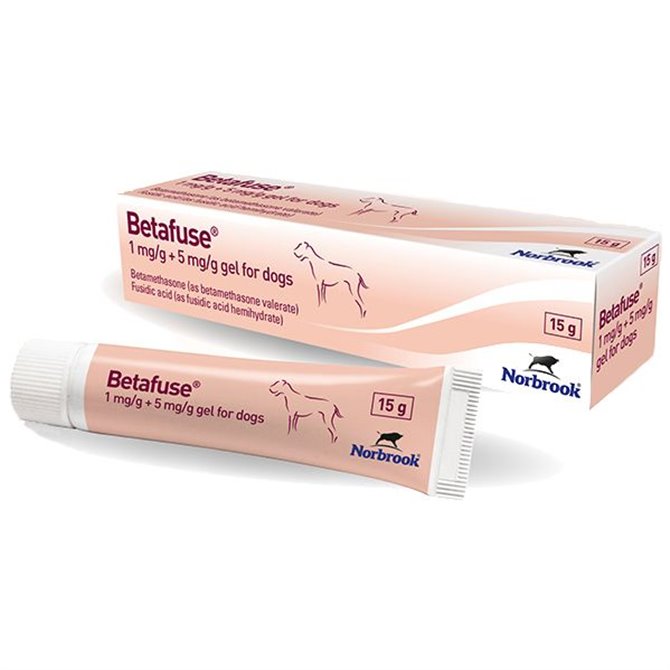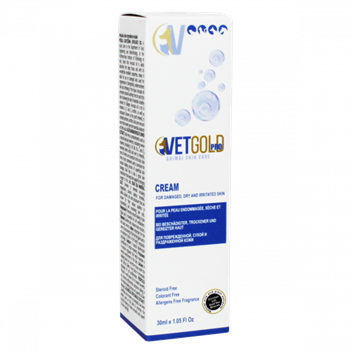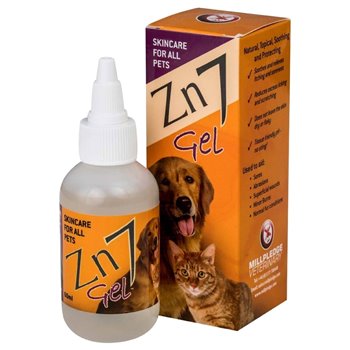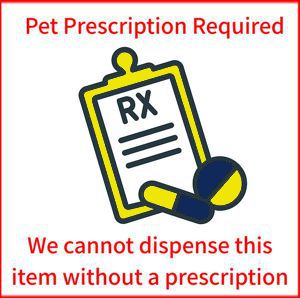
15g Betafuse Gel for Dogs
860451
Betafuse Gel for Dogs is a dermatological gel with antibacterial and anti-inflammatory properties. VETERINARY PRESCRIPTION REQUIRED
Product Features
- Pack Size: - 15g Tube
- Target Animal: - Dog (Canine)
- Related Condition: - Pyoderma in Dogs
- Pet Prescription Required?: - Yes
- Active Ingredient: - Betamethasone Valerate & Fusidic Acid
- Product Name: - Betafuse 1 mg/g + 5 mg/g Gel for Dogs
More Information
Description
Betafuse 1 mg/g + 5 mg/g Gel for Dogs - 15g Tube
Betafuse contains Betamethasone Valerate, Fusidic Acid
Betafuse 1 mg/g + 5 mg/g Gel for Dogs. For the treatment of acute surface pyoderma in the dog, such as acute moist dermatitis ('hot spots') and intertrigo (skin fold dermatitis), caused by Gram-positive bacteria sensitive to fusidic acid.
Contraindications
•Do not use Betafuse for the treatment of deep pyoderma.
•Do not use Betafuse in pyotraumatic furunculosis and pyotraumatic folliculitis with 'satellite' lesions of papules or pustules.
•Do not use Betafuse where fungal, viral infection or demodicosis is present.
•Do not apply Betafuse to the eye.
•Do not use Betafuse over large surface areas or for prolonged treatment.
•Do not use Betafuse in dogs suffering from impetigo or acne.
•Do not use Betafuse in dogs with unstabilised or untreated Cushing's syndrome or diabetes mellitus.
•Do not use in dogs with pancreatitis.
•Do not use Betafuse in dogs with gastrointestinal ulcers.
•Do not use Betafuse in cases of known hypersensitivity to the active substances or to any of the excipients.
Wash hands after having applied the product. Care should be taken to avoid Betafuse contact with treated areas of the animal, for the duration of the treatment period. Care should be taken to avoid accidental ingestion by a child. In the case of accidental ingestion, seek medical advice immediately and show the package leaflet to the physician. Adverse reactions (frequency and seriousness) Prolonged and intensive use of topical corticosteroid preparations or treatment of a large cutaneous surface (>10%) is known to trigger local or systemic effects including suppression of adrenal function, thinning of the epidermis and delayed healing. Locally applied steroids may cause depigmentation of the skin.
Discontinue use with Betafuse if hypersensitivity develops to the product. Use during pregnancy, lactation or lay The use of the product during pregnancy and lactation is not recommended. The safety of the product has not been assessed during pregnancy and lactation. Laboratory studies have demonstrated that topical application of betamethasone in pregnant females may lead to malformations in neonates. Small amounts of betamethasone can pass the blood-milk-barrier. Interaction with other medicinal products and other forms of interaction
Concurrent treatment with steroids and NSAIDs may increase the risk for the development of gastrointestinal ulcers. Amounts to be administered and administration route Cutaneous use. First, the hairs covering the lesions should be gently clipped. The affected area should then be thoroughly cleaned with an antiseptic wash before daily application of the gel. The amount applied should cover the affected area in a thin layer.
Apply approximately 0.5 cm length of Betafuse gel per 8 cm2 of lesion, twice daily, for a minimum period of 5 days. Treatment should continue for 48 hours after the lesion has resolved. The treatment period should not exceed 7 days. If there is no response within three days, or the condition deteriorates, the diagnosis should be re-evaluated. Overdose (symptoms, emergency procedures, antidotes), if necessary For possible signs see "Adverse reactions (frequency and seriousness)" above.
Withdrawal period(s) Not applicable.
Pharmacological particulars Pharmacotherapeutic group: Corticosteroids, combinations with antibiotics. ATCvet code: QD07 CC01 Pharmacodynamic properties Betamethasone valerate is a potent synthetic corticosteroid (dexamethasone-analogue) with anti-inflammatory and anti-pruritic activity when applied topically as well as mild mineralocorticoid properties. Fusidic acid hemihydrate has a steroidal structure but does not possess any steroid-like effects. It belongs to the class of antibiotics called Fusidanes.
Fusidic acid hemihydrate acts by prohibiting the protein synthesis of bacteria when it binds to elongation factor G (required for translocation on the bacterial ribosome after peptide bond formation during protein synthesis). Its action is largely bacteriostatic, but at high concentrations (2 to 32-fold higher than the MIC) the effect may be bactericidal. Fusidic acid hemihydrate has activity against Gram‑positive bacteria, namely Staphylococcus spp. (particularly S. pseudintermedius) including penicillinase producing species. It is also active against streptococci. Pathogenic bacteria Fusidic acid Sensitive / Resistant Fusidic acid MIC Gram-positive bacteria - Staphylococcus pseudintermedius Sensitive MIC90≅ 0.25-4 µg/ml - Streptococcus spp.us Sensitive MIC90≅ 8-16 µg/ml - Corynebacteria spp. Sensitive MIC90 ≅ 0.04 – 12.5 µg/ml Gram-negative bacteria - Pseudomonas spp. Resistant >128 µg/ml - E.Coli Resistant >128 µg/ml Data based on studies conducted mainly in Europe but also in North America between 2002 and 2011. Two major mechanisms of resistance to fusidic acid hemihydrate have been reported in S. aureus – the alteration of the drug target site which is due to chromosomal mutations in FusA (encoding elongation factor EF-G) or FusE encoding ribosome protein L6, and the protection of the drug target site by FusB family proteins, including fusB, fusC, and fusD. The fusB determinant originally was found on the plasmid in S. aureus but has also been found on a transposon-like element or in a staphylococcal pathogenicity island.
No cross-resistance between Betafuse and other antibiotics that are in clinical use has been identified. Pharmacokinetic particulars In vitro data obtained from a study on dog skin indicate that 17 % of the applied dose of betamethasone and 2.5% of the applied dose of fusidic acid hemihydrate are absorbed over 48 hours after the administration of the product to the skin. Betamethasone valerate is absorbed after topical application. Absorption after administration to inflamed skin is likely to be greater. Following systemic absorption betamethasone can cross the blood-brain barrier, the blood‑placenta barrier and, in small amounts, may pass into the milk of lactating animals.
Legal category:
Betafuse is a POM-V (Pet Prescription Required)
You may also like

VetGold Cream - 30ml
VetGold cream is specially formulated to promote the natural healing of dry itchy skin.
VetGold cream is an all-natural Dead Sea product enriched with minerals, natural oils, and plant extracts that rejuvenate, revitalise and moisturise your pet's skin cells.
VetGold cream does not contain any medicinal chemicals such as cortisone steroids or synthetic vitamins which with prolonged use may cause harm.

Zn7 Zinc Skin Soothing Gel - 60ml
Zn7 Zinc Skin Soothing Gel – Relief for Pets' Skin Irritations
Zn7 Zinc Skin Soothing Gel is a veterinary-formulated topical solution designed to alleviate various skin conditions in pets. This gel utilises neutralised zinc combined with amino acids to provide soothing relief from itching, dryness, and irritation. It is suitable for managing superficial wounds, hot spots, abrasions, and other dermatological issues in dogs, cats, and other animals.
How Does Zn7 Zinc Skin Soothing Gel Work?
Zn7 Gel contains neutralised zinc gluconate complexed with the amino acids L-lysine and taurine. This formulation enhances the bioavailability of zinc, allowing it to penetrate the skin effectively and exert its therapeutic effects.
-
Neutralised Zinc Gluconate: Zinc is known for its anti-pruritic (anti-itching) and healing properties. In the neutralised form, zinc gluconate is stabilised at a pH that matches the skin's natural environment, promoting better absorption and efficacy.
- Amino Acids (L-lysine and Taurine): These amino acids aid in stabilising the zinc and facilitate its transport across cell membranes. This combination ensures that zinc reaches deeper skin layers, enhancing its soothing and healing actions.




